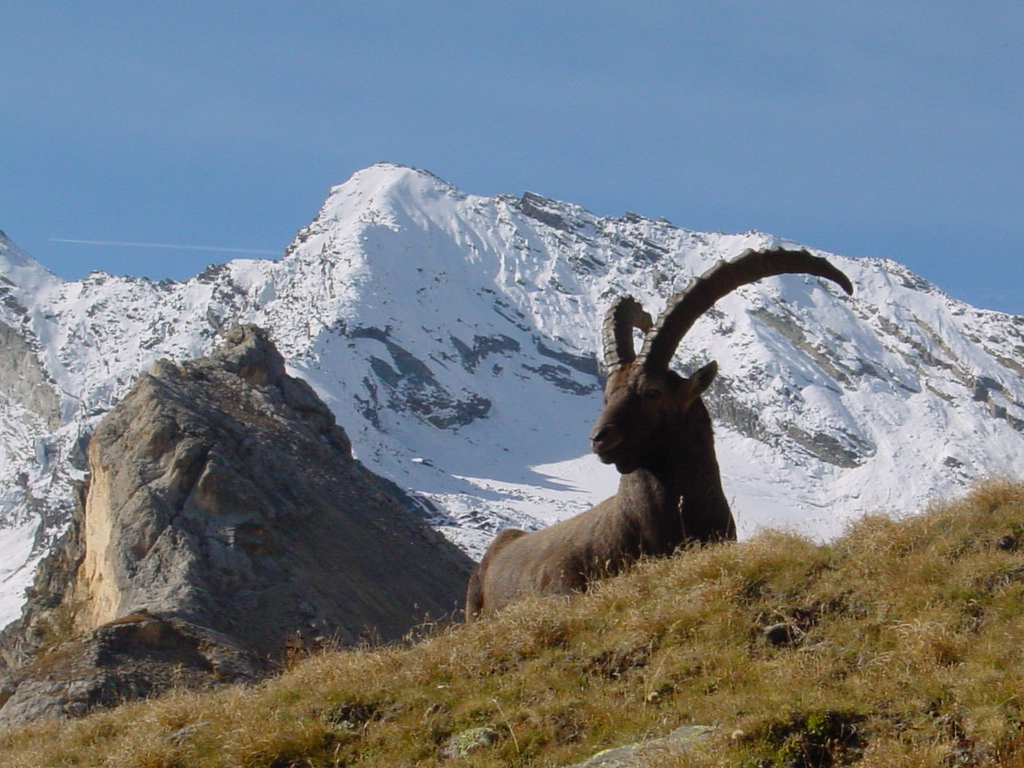- Alpine Ibex
Taxobox
name = Alpine Ibex
status = LR/lc | status_system = IUCN2.3

image_width = 300px
regnum =Animal ia
phylum = Chordata
classis =Mammal ia
ordo =Artiodactyla
familia =Bovidae
genus = "Capra"
species = "C. ibex"
range_
range_map_caption=Range map on alpes
binomial = "Capra ibex"
binomial_authority = Linnaeus, 1758The Alpine Ibex ("Capra ibex")— commonly called by its local names in the various languages - French bouquetin, German steinbock, Italian stambecco, Slovenian kozorog, or by its Latin nickname: capricorn—is the species ofibex that lives in the EuropeanAlps . TheSpanish Ibex ("Capra pyrenaica") and theMiddle East ernNubian Ibex ("Capra ibex nubiana") are very close relatives of the Alpine Ibex — the Spanish form is generally considered specifically distinct, but the Nubian is usually considered asubspecies of Alpine Ibex.Habitat
Being an excellent climber, its habitat is the rocky region along the snowline above alpine forests of the European Alps. They tend to occupy steep, rough terrain at elevations of convert|6500|-|15000|ft|m.
Appearance
Male specimens commonly grow to a height of about convert|1|m and reach a weight of about convert|100|kg. Females are usually only half the size of males. Apart from size, males can also be distinguished by their prominent beard. Older males will tend to grow beards under their chin. Both male and female ibexes have large, backwards-curving horns although those of the male are substantially larger and can grow to an impressive length of up to 1 m. These horns are used to defend themselves from predators such as wolves,
lynx es,bear s andfox es. Small kids may also be susceptible to attacks from large predatory birds such aseagle s. The Ibex has a brownish grey colouring in the summer which changes during the winter months to a richer, darker brown. It is related to the Nubian and Siberian ibexes.Foraging behaviour
Ibexes are strictly
herbivorous and survive on a diet of grass, moss, flowers, leaves and twigs. If leaves and shoots are out of reach, Ibexes often stand on their rear legs to reach this food. They eat during late afternoon and evening hours, descending at this time from the high steep cliffs and into the lower alpine meadows below. The rest of the day is spent in the higher altitude of the cliffs and hills. This pattern of remaining at higher altitudes during the bright daylight hours helps protect them from predators who do not inhabit such high terrain. In the winter, Ibexes also tend to live at lower altitudes since food is more scarce. The need to drink every few days in the summer causes the Ibexes to seek permanent residence within proximity to a dependable water source during this season. If predators are after them, Ibexes will hide in the rocks of the steep cliffs.Breeding habits
Male ibexes often group together in bachelor herds during summer; in late autumn, during rut, males typically go their own ways and seek out a female herd of their own. During breeding season, fight rituals occur between males in order to determine who is entitled to breed with the available females. Despite the large, heavy horns of the males playing a part in this ritual, it is rare that they are physically harmed in the process. After conception, and gestation period of 6 months, a single kid (twins rarely occur) is born around May.
History
The steinbock has for a long time been regarded as a mystical animal; almost all of its body parts and its excrement were sought after as cures for various illnesses and as ingredients for magical potions. As a result of very extensive hunting, the steinbock was almost extinct as early as the beginning 19th century. Thanks to the efforts of a small group of foresters, the last remaining animals in
Gran Paradiso were protected in 1816. In 1854,Victor Emmanuel II of Italy placed the animals under his personal custody. Today, after extensive and ongoingreintroduction programs, the population in the wild is estimated at about 30,000.References
*
External links
* [http://www.ultimateungulate.com/Artiodactyla/Capra_ibex.html Ultimate Ungulate factsheet]
* [http://animal.discovery.com/guides/mammals/habitat/alpine/ibex.html Animal Planet Mammal Guide]
* [http://encarta.msn.com/media_461517134/Alpine_Ibex.html Encarta Alpine Ibex Entry]
* [http://ladywildlife.com/animal/alpineibex.html Lady Wildlife Alpine Ibex Facts]
* [http://ladywildlife.com/animal/alpineibex1.htm Lady Wildlife Alpine Ibex Images]
Wikimedia Foundation. 2010.
